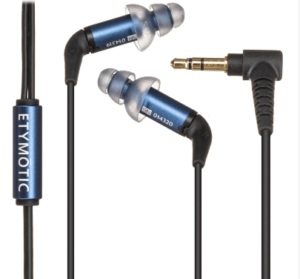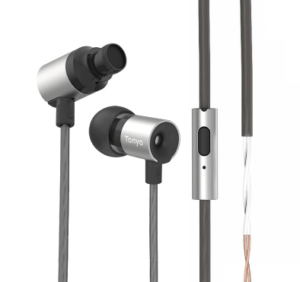The best iem headphones for gaming accurately reproduce highs and lows with rich balance and detail. If you are looking for a pair of in ear monitor headphones for gaming or something that produces very good sound, these will suit both scenarios.
The high-gloss surface adds a shiny gunmetal finish to the earphones, giving them a luxurious and sleek look.
Best IEM Headphones for Gaming in 2025
1. Etymotic ER2XR Headphone

The ER2XR IEM Headphone follows Etymotic’s take on classic Diffuse Field tuning. The overall sound here is reference-oriented with a woo-woo feel to the bass making it the perfect In-Ear Monitor for Gaming season.
The bass lacks texture but is fairly clean with adequate slam. Some people may find the ER2XR’s midrange to be slightly forward of the upper midrange. But I’ve never seen it scream.
The technology is excellent too, probably the best I’ve heard for under $200. The ER2XR’s biggest weaknesses are its darker treble response and narrow imaging.
Oh, and the fit too. It’s an unpleasant, unpleasant fit that you’d be better off living with because the price/performance ratio is so good that it’s almost unfair.
2. Sure Aonic 5

Shure’s Aonic 5 certainly lets you see the inner workings, but it’s the way they sound that earns them their spot on this list. Some of Shure’s top-of-the-line wireless monitors are the in-ears to choose if you really care about sound quality and are willing to pay a pretty penny to get them.
Aonic 5 uses three HD balanced drivers in a dual woofer and single tweeter configuration. If you have the right sources and ingredients, the results can be quite amazing.
The vocals sound particularly rich and natural, with bewildering detail and an incredibly clear presentation. Incredibly sonically transparent, keep in mind that any harsh recording will be exposed as the Aonic 5 takes no prisoners with its clear “tell it like it is” style.
As usual, Shure provides plenty of tips to help you find the perfect fit for your buds, but it also provides two additional nozzles that can be used to change the balance of the sound.
The ones labeled ‘Bright’ put too much emphasis on the top end for our liking, but the ‘Warm’ pair offers a subtle increase in weight and substance. But we still recommend sticking to the default settings. Because this is where you can achieve the most balance.
If you have a decent DAC/headphone amp that can drive it, the Shure Aonic 5 will do exactly that. If not, the Aonic 3 might be worth a look.
3. Moondrop Aria

Moondrop Aria has once again undercut itself with the cheapest and newest example of Moondrop. So who are we to complain to? The Aria follows a tuning not dissimilar to the Harman but is warmer and generally much easier on the ears.
It’s not the best IEM in its price range (it’s actually slower on transients and doesn’t layer as much as its little brother, the SSR).
However, the tone is very pleasant and natural. Stacked with 12kHz peaks in the upper register that give it a pleasant haziness, the Aria is certainly not lacking in that silly musical jargon. This is one of my favorite IEMs under $100, and you can enjoy it for hours on end.
4. Shure Aonic 3

Anyone who prioritizes sound quality above all else but still prefers the smaller form factor of in-ears should seriously consider what the Shure Aonic 3 has to offer.
They are simple but expertly crafted IEMs that, as far as we know, have few serious competitors at this level thanks to their dedication to excellent music reproduction.
In terms of design, the Aonic 3 looks like a classic IEM, fed by a pair of nozzles with inline controls for convenient wired connectivity.
A choice of nine eartips that offer superior isolation and comfort makes getting a good fit simple, and the built-in microphone lets you take calls without having to take out your phone all the time.
Of course, the real reason I recommend the Aonic 3 is because of its unrivaled audio at this price. The 2023 winner is an expert at handling dynamics and detail with a sense of rhythm and timing that brings energy and life to the music he delivers.
If you want a pair of wired in-ear headphones that offer a step up in sound quality than the cheaper Sound Magics below, I can’t recommend these Shures enough.
5. Tanchijim Tanya

Tanya surprised me because Tanchjim isn’t really known for making cheap IEMs. It’s a more traditional V-shaped tuning with a bit of spice in the upper mid and upper registers. Despite this, the overall sound signature is surprisingly balanced.
Contrary to what you might expect, the midrange isn’t particularly poppy and falls more towards a warm feel, and the Tanya avoids the 5kHz peak seen in many similar IEMs. Sure, there are not a lot of treble extensions,
but the Tanya actually has decent imaging capabilities as well, with above-average soundstage width, height, and layering ability.
Did I mention that these IEMs also come with some pretty cool accessories and a microphone (if you choose that option)? Listeners who want to have fun at $25 will be hard-pressed to find a better value.
6. ETYMOTIC ER3SE and ER3XR IEMS

In Etymotic’s acclaimed latest IEM lineup, the ER3SE and ER3XR utilize precisely matched, high-performance balanced armature drivers.
These high-sensitivity IEMs are ideal for mobile sources such as smartphones or portable digital audio players. For those who prefer a stronger bass response, the XR version offers a modest bass boost compared to the SE.
Headfonia reviewer Lieven says: “If you know that most custom IEMs offer -26dB isolation, you will immediately know that these Etymotic IEMs are very special. These ER3 and ER4 IEMs are the best detachable IEMs in my collection.
In fact, this product has proven to have the highest level of noise isolation among all earphones or headphones currently on the market. Very impressive!“
7. Sennheiser IE 900

Sennheiser IE 900 is the best gaming in-ear headphones for those on a budget. Shure isn’t the only company capable of releasing great wired in-ear headphones. Sennheiser’s excellent IE 900 headphones will appeal to purists
who want the best possible audio from high-quality sources and are packaged like premium in-ear headphones thanks to six eartip options and three cables to choose from regular 3.5. mm and balanced 2.5mm/4.4mm connectors.
The only thing they don’t have is an in-line remote control, but considering how these bad boys sound, that’s almost forgivable. This is a step up from the amazing Shure Aonic 5 above.
With rigidity and minimal vibration in mind, Sennheiser’s engineers chose a single driver rather than the sophisticated multi-unit approach taken by many competitors, and the results are outstanding.
The IE 900 delivers an incredibly clear and open sound, allowing you to get deeply involved in the creation of your recordings with skill and passion.
They are also confident and insightful, discovering lower-level information hierarchies and organizing every track they encounter into a structured, cohesive whole.
FAQs
What are IEMs used for?
IEMs (in-ear monitors) are designed to allow sound mixers and performing musicians to hear music from a variety of audio sources on stage.
For example, a guitarist in a band can hear a mix of different instruments and vocals directly in his ears, isolating them from the screams and cheers of the audience. Typically, they fit into the ear canal to suit the shape of the musician’s ear.
An IEM has three components: That is, a transmitter that sends audio to a receiver; A receiver worn by the performer and connected to an earpiece; And there is an earphone part that cancels out the noise to produce a clear sound.
IEMs were originally created for stage performances by musicians and singers, but these days, even audiophiles can purchase them at a variety of prices.
Do IEMs sound better than earbuds?
IEMs sound better than earbuds due to the way they fit into your ears and the different technologies used to emit sound.
IEMs are placed inside the ear canal, while regular earbuds are placed just outside the ear canal. This means it’s great at blocking out ambient sounds and isolating music.
Additionally, most earbuds only have one or two drivers per bud. IEMs have between two and six drivers, each focused on a specific frequency.
Do IEMs hurt your ears?
IEMs should not hurt your ears and should be comfortable to wear. It must be fitted correctly to fit the shape of the ear canal. If not fitted properly and worn for a long period of time, the user may suffer ear injury.
Pain may also occur if the IEM is inserted too deeply into the root canal. If this is your first time wearing IEMs, attach them first before trying them out.
